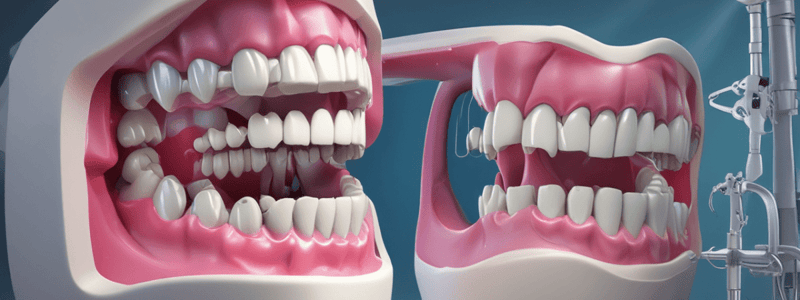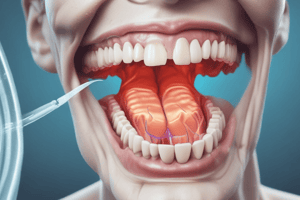Podcast
Questions and Answers
What is the primary reason for conducting a 5-year follow-up examination for a patient with an infraction?
What is the primary reason for conducting a 5-year follow-up examination for a patient with an infraction?
- To assess the effectiveness of endodontic intervention
- To monitor for signs of apical or periradicular periodontitis (correct)
- To determine if the root has stopped development
- To detect cracks or sharp edges in the enamel
What type of fracture is defined as a fracture of the enamel only or the enamel and dentin without pulp exposure?
What type of fracture is defined as a fracture of the enamel only or the enamel and dentin without pulp exposure?
- Uncomplicated crown fracture (correct)
- Crown-root fracture
- Complicated crown fracture
- Root fracture
What is the primary objective of managing tooth displacement?
What is the primary objective of managing tooth displacement?
- To reattach the broken-off piece
- To promote root growth
- To close exposed dentinal tubules (correct)
- To prevent further tooth displacement
What radiographic imaging technique is used to diagnose traumatic injuries such as root fractures and periapical radiolucencies?
What radiographic imaging technique is used to diagnose traumatic injuries such as root fractures and periapical radiolucencies?
What is the primary indication for endodontic intervention in a patient with a traumatic injury?
What is the primary indication for endodontic intervention in a patient with a traumatic injury?
What is the primary diagnostic tool for diagnosing root fractures?
What is the primary diagnostic tool for diagnosing root fractures?
What percentage of dental injuries involve crown fractures that involve enamel, dentin, and pulp?
What percentage of dental injuries involve crown fractures that involve enamel, dentin, and pulp?
What is the primary goal of vital pulp therapy in immature teeth?
What is the primary goal of vital pulp therapy in immature teeth?
What is the primary indication for pulpectomy in mature teeth?
What is the primary indication for pulpectomy in mature teeth?
What is the primary consideration for the treatment of crown-root fractures?
What is the primary consideration for the treatment of crown-root fractures?
What is the primary diagnostic tool used for the diagnosis of root fractures?
What is the primary diagnostic tool used for the diagnosis of root fractures?
What is the primary goal of temporary stabilization of loose tooth fragments in crown-root fractures?
What is the primary goal of temporary stabilization of loose tooth fragments in crown-root fractures?
What is the characteristic of a chisel fracture?
What is the characteristic of a chisel fracture?
What is the indication of a severe pain on biting and tenderness to percussion?
What is the indication of a severe pain on biting and tenderness to percussion?
What is the purpose of taking three angled radiographs (45°, 90°, 110°) in root fracture diagnosis?
What is the purpose of taking three angled radiographs (45°, 90°, 110°) in root fracture diagnosis?
What is the management of a root fracture with no mobility or displacement?
What is the management of a root fracture with no mobility or displacement?
What is the classification of a root fracture based on its direction?
What is the classification of a root fracture based on its direction?
What is the indication of a radiographic examination in a patient with a suspected root fracture?
What is the indication of a radiographic examination in a patient with a suspected root fracture?
What is the primary objective of repositioning and splinting in tooth displacement?
What is the primary objective of repositioning and splinting in tooth displacement?
What is the recommended follow-up schedule for a patient with tooth displacement?
What is the recommended follow-up schedule for a patient with tooth displacement?
What is the recommended treatment approach for a patient with an apical root fracture without displacement or mobility?
What is the recommended treatment approach for a patient with an apical root fracture without displacement or mobility?
What is the primary consideration when evaluating the length of the remaining root in a patient with a coronal root fracture?
What is the primary consideration when evaluating the length of the remaining root in a patient with a coronal root fracture?
What is the primary benefit of using a functional (semirigid) splint in tooth displacement management?
What is the primary benefit of using a functional (semirigid) splint in tooth displacement management?
In a patient with a coronal root fracture, what is the primary goal of endodontic treatment?
In a patient with a coronal root fracture, what is the primary goal of endodontic treatment?
What is the recommended treatment for mid-root fractures when both segments are necrotic?
What is the recommended treatment for mid-root fractures when both segments are necrotic?
What is the outcome of healing with calcified tissue in root fractures?
What is the outcome of healing with calcified tissue in root fractures?
What is the educational aim of this lecture regarding traumatic injuries?
What is the educational aim of this lecture regarding traumatic injuries?
What is the outcome of healing with interproximal connective tissue in root fractures?
What is the outcome of healing with interproximal connective tissue in root fractures?
What is the recommended treatment for coronal segments treated as immature roots?
What is the recommended treatment for coronal segments treated as immature roots?
What is the outcome of healing with interproximal bone and connective tissue in root fractures?
What is the outcome of healing with interproximal bone and connective tissue in root fractures?
What is the primary reason for referring a patient with a traumatic injury to a medical examination?
What is the primary reason for referring a patient with a traumatic injury to a medical examination?
How long may it take for normal blood flow to return to the coronal pulp of a traumatized fully formed tooth?
How long may it take for normal blood flow to return to the coronal pulp of a traumatized fully formed tooth?
What is the recommended frequency for repeating pulp tests after a traumatic injury?
What is the recommended frequency for repeating pulp tests after a traumatic injury?
What is the primary purpose of taking multiple radiographs for traumatic injuries?
What is the primary purpose of taking multiple radiographs for traumatic injuries?
What is the primary advantage of using Cone Beam Computed Tomography (CBCT) in traumatic injuries?
What is the primary advantage of using Cone Beam Computed Tomography (CBCT) in traumatic injuries?
What is the primary consideration in the management of tooth displacement?
What is the primary consideration in the management of tooth displacement?
What is the primary feature of a traumatized tooth that affects its response to pulp tests?
What is the primary feature of a traumatized tooth that affects its response to pulp tests?
What is the primary indication for radiographic examination in traumatic injuries?
What is the primary indication for radiographic examination in traumatic injuries?
What is the primary role of the International Association of Dental Traumatology (IADT) in dental traumatology?
What is the primary role of the International Association of Dental Traumatology (IADT) in dental traumatology?
What is the primary consideration in the management of alveolar fractures?
What is the primary consideration in the management of alveolar fractures?
Flashcards are hidden until you start studying





